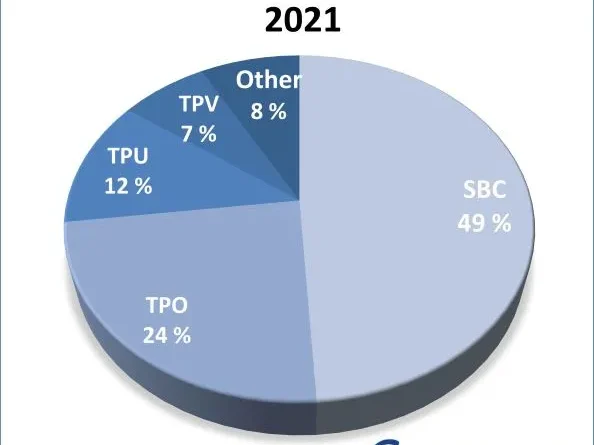Thermoplastic elastomer market forecast at 27 billion by 2031
Konstanz, Germany – Soft and flexible, yet easy and inexpensive to process: Thermoplastic elastomers (TPE) are elastic like rubber at room temperature, but can be melted and repeatedly molded like standard plastics. “Thermoplastic elastomers offer high strength and are robust; they can be welded watertight and colored in a variety of ways. In principle, TPEs can also be recycled,” explains Oliver Kutsch, CEO of the market research institute Ceresana: “These innovative materials are conquering more and more application areas. TPEs are also interesting because components can be made from renewable raw materials or combined with bioplastics.” This is the fourth time Ceresana has analyzed the global market for thermoplastic elastomers: By 2031, revenues generated with TPEs are expected to increase to almost USD 27 billion. However, growth will be driven not only by increasing demand, but also by price inflation.
Because of their versatile properties, TPEs are used in a wide variety of applications. Their good abrasion resistance makes them a suitable material for shoe soles and for soft-touch handles, such as those of toothbrushes, bicycle handlebars or tools. Since TPEs do not require plasticizers due to their high elastomer content, they can be processed into hoses for the pharmaceutical, medical and food industries as an alternative to PVC. Nevertheless, the main customer for TPE manufacturers is the automotive industry: worldwide, around 33% of all TPE products are used in this industry. Applications range from fabric coatings, seals, cable sheathing and insert mats to covers for airbags and bumpers. TPEs are also increasingly being used by other industries, such as mechanical engineering, electrical engineering and electronics, and the sports and toy industries. The construction industry, uses roof membranes made of TPE.
The production of thermoplastic elastomers is dominated by manufacturers in Asia: it accounts for roughly two thirds of global TPE production, followed by North America and Western Europe. The market shares of the various TPE grades vary greatly and depend above all on the different size of the respective user industries. By far the most widely used TPE grade is styrenic block copolymers (TPS, TPE-S or SBC), which account for around 49% of global demand. Their use ranges from blending in adhesives to asphalt modification in road construction. Thermoplastic polyolefins (TPO), which are mainly used in the automotive industry, come in second. Another important type of TPE is thermoplastic polyurethane (TPU), which is used for dashboards and housing shells, for example.

